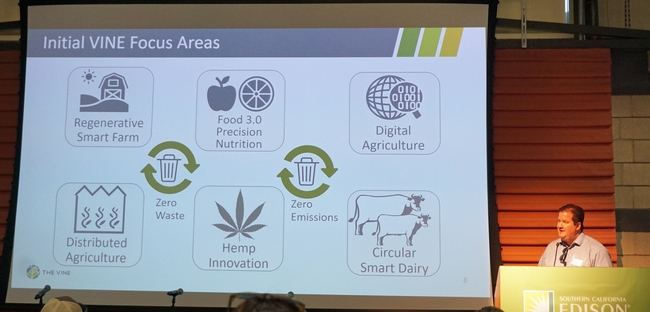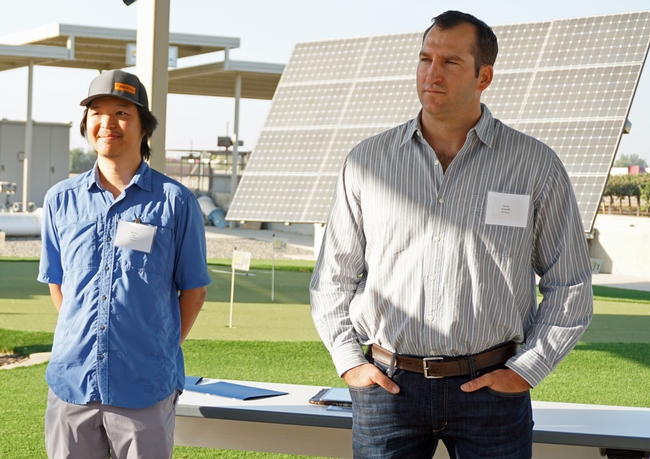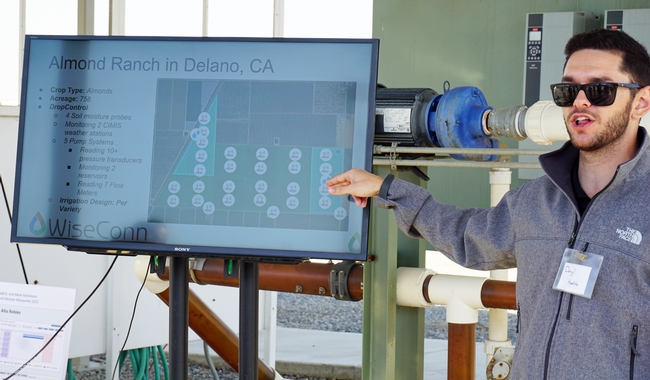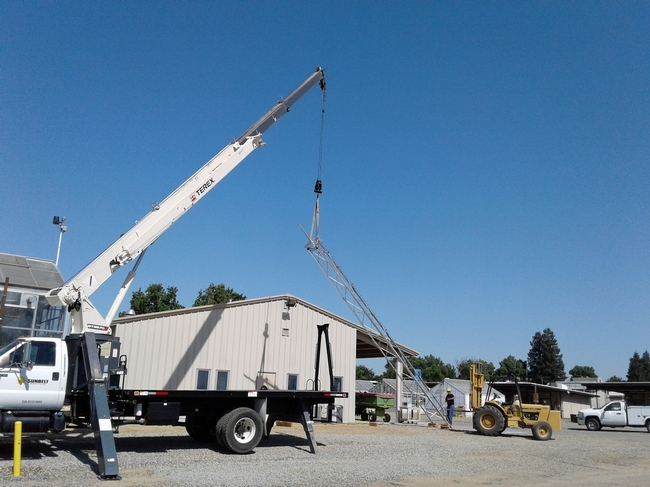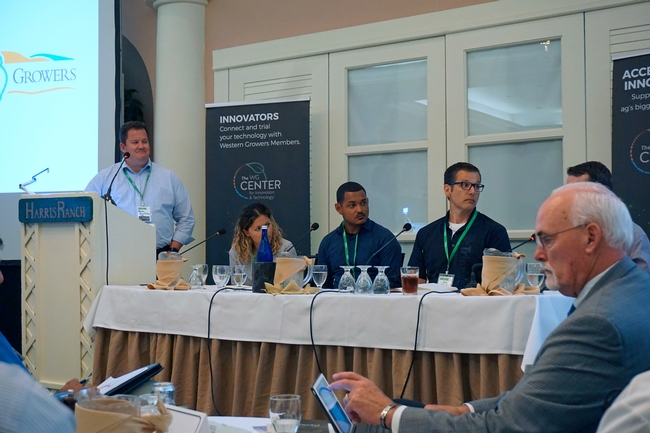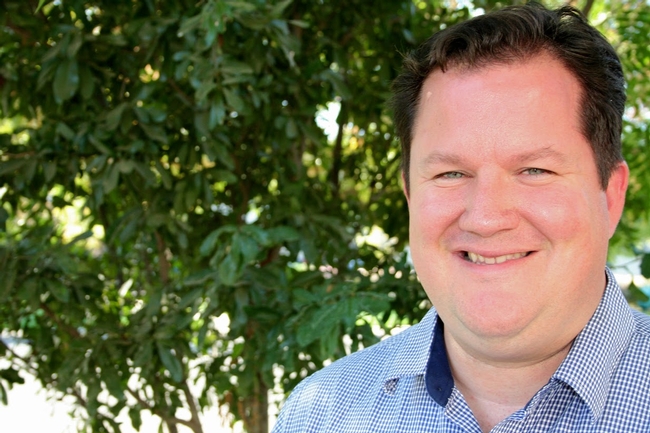Posts Tagged: Gabe Youtsey
Farming technology focus at Open Farm 2019
From robot vacuum cleaners and doorbell cameras to social media and e-commerce, technology is continually transforming lives and businesses. The world's oldest industry – agriculture – is no exception.
Remote sensors are all but eliminating the need for farmers to walk plant rows and make decisions based solely on observations, experience and intuition. New technologies that gather and analyze data can optimize crop needs, reduce environmental impacts, increase efficiency, cut energy costs and save water. The latest innovations were on display at the fourth annual Open Farm conference Oct. 23 in Tulare.
A demonstration by PowWow Energy showed artificial intelligence technology not only improving farming, but also spinning off new ideas and local businesses in rural communities. PowWow supports farms who have solar panels with information to optimize their return on investment. By monitoring weather, utility rates and meters, and the panels' energy generation, the company calculates precisely when energy losses caused by dust on the solar panels are valued higher than the cost of cleaning them. When it's time to wash the panels, farmers receive a text notification.
That got Tulare County dairy farmer Justin Roeloffs thinking about the growing need to efficiently clean dust from solar panels. He built a solar panel cleaning system that was so effective, he started a business – Roeloffs Solutions – to offer panel cleaning to other solar owners, creating new jobs in the farming community.
“The almond season is a disaster for solar panels,” Roeloffs said. “Some farmers buy a kit and do it themselves, but we had many calls for our service the first month in business.” Last summer, Roeloffs Solutions cleaned panels that generate 30 megawatts of power.
The founder of Concentric Power, Brian Curtis, explained the business he built to manage the energy usage and needs of large food processors, beginning in the Salinas Valley. The system allows businesses to save money on their energy bills, maximize the use of renewable energy and maintain reliable energy availability, even during blackouts and brownouts. Concentric Power combines wind, solar, co-generation and battery storage to develop a company's own micro-grid.
“The recent public safety power shutoffs are ringing our bell,” Curtis said. “The stars have aligned for us.” So far three Salinas Valley food processors and one in Bakersfield have installed the micro-grid systems. Curtis said energy intensive ag industries – such as dairies, cheese processors and wine producers – are potential clients.
A variety of other automation solutions were also shared at Open Farm:
- Darryl Hadlich of WiseConn said the company's precision irrigation timing system – monitored by infield sensors and controlled by in-field nodes – allows farmers to schedule, start and end irrigation and fertigation using their cellphones or desktop computers. The associated software also shows when energy companies offer lower, off-peak rates to enable irrigation scheduling when the cost to operate the pump will be at its lowest.
- Conner Kingman of Kingman Ag Service is perfecting technology to reconfigure the tractors farmers already own with artificial intelligence-aided computers to pull a wide variety of farm implements through the field, such as a spring tooth cultivator, mower, shredder and sprayer. The driverless tractors reduce labor needs, and enable farm work to continue around the clock without breaks or worker safety concerns.
- Jose Baer at PowWow Energy detailed programmable irrigation systems for small and large farming operations. The field is monitored with aerial images and uses data from in-field sensors for targeted water application.
- John Cardoza of Sustainable Conservation explained a collaborative research project that studied methods for dairy wastewater management using sensors, sand media filters and drip irrigation. In the study, nitrous oxide emissions were cut by 70%, water use by 36% and nitrogen applications by 45%.
During a researcher and industry panel on the state of technology integration from the grower's perspective, participants reflected on how technology will help prepare for the future. The panel was moderated by Dennis Donahue, director of Western Growers Center for Innovation and Technology:
- Director of the Tulare County Resource Conservation District Mike Chrisman, a long-time Tulare County farmer, noted that data will be increasingly critical for farming as California agriculture enters the Sustainable Groundwater Management Act era in 2020. The law requires that California groundwater usage be “sustainable” by 2040 – meaning that the amount that is drawn out must match the amount that is recharged. “This will change the way we all do business,” Chrisman said. “Agriculture in 20 years won't look like it looks today.”
- Jeff Dahlberg, director of the UC Kearney Agricultural Research and Extension Center and a sorghum extension specialist, said high technology companies will rely on UC researchers to confirm that their products are meeting expectations. UC scientists can contribute by applying their knowledge on plant growth and development. “We understand biology and how plants use water,” he said. “We will be asked to ground truth technology.”
The event is a collaborative effort by UC Agriculture and Natural Resources, Fresno State's BlueTech Valley, the California Energy Commission, PowWow Energy, West Hills College and the Western Grower Center for Innovation and Technology. Open Farm 2019 was hosted at the Southern California Edison Energy Education Center.
Connectivity is key for high-tech farms of the future
The dizzying impact of the digital revolution on many sectors of society – from retail to law enforcement, politics and entertainment – has also altered the picture on California farms.
With technology, farmers have found ways to reduce pesticide use, increase irrigation efficiency, reduce travel into the fields, manage people better, and deal with labor shortages. Much more can be done.
To connect farmers interested in ag innovations with researchers who can confirm the potential of new technologies, UC Agriculture and Natural Resources created Verde Innovation Network for Entrepreneurship, or the VINE. The program has launched a website at https://thevine.io, a place for farmers, food entrepreneurs, researchers and technology professionals to find the resources they need to build, launch and grow agricultural innovations.
“The VINE brings together academia across UC, the Cal-State University system, and community colleges with innovators in technologies like artificial intelligence, machine learning, robotics, indoor agriculture and others,” said Gabe Youtsey, UC ANR chief innovation officer. “We want to create rural testbeds to develop technology. UC ANR's research and extension centers are well set up to do that.”
UC ANR has research and extension centers (RECs) across California, in locations representative of different agricultural ecosystems – from the desert southwest to the intermountain region near the Oregon border. The VINE recently invited technology companies and farmers to the UC Kearney Agricultural Research and Extension Center in Parlier to mark the installation of a wifi tower that will bathe the 330-acre agricultural research station in high-speed wireless internet.
The project built on the partnership with the Corporation for Education Network Initiatives in California (CENIC) that brought ultra-fast (100Gbps) broadband capability to Kearney offices and laboratories two years ago. UC ANR collaborated with Orange Silicon Valley and BlueTown to extend the connectivity via wireless transmission to every corner of the research fields.
Orange Silicon Valley is a division of Orange in France, a telecommunications provider. BlueTown, based in Denmark, provides low-cost, sustainable wifi to people in rural areas around the world.
The wifi update enables researchers at Kearney to collect and view data without any delay.
“Now we can do real-time data collection,” said Jeff Dahlberg, Kearney director. “We need science to back up technology. We can use Kearney to ground-truth new technologies before farmers make a decision to buy into it.”
Internet access may not be critical to farming at the moment, but as growers adopt more technology-driven applications on their farms, a fast, reliable and widespread internet will be imperative.
“We're setting a foundation for the future,” Youtsey said. “The innovation infrastructure to really create the solutions and tie them together is broadband.”
The wireless system serves as a model and possible resource for rural communities interested in offering high-speed internet to residents. The Kearney wifi offers benefits to the partners that helped make it a reality. Orange Silicon Valley is working on bringing internet to remote places in Africa and India.
“They wanted a test facility, a place and a relationship for research and development in their backyard,” Youtsey said. “We have conditions at Kearney that are similar to the rural areas around the world where they work.”
Kearney was the first UC ANR REC to be equipped with connectivity to serve as a field innovation center.
“Eventually, multiple centers across California will have the infrastructure to test and evaluate technology in the places where food grows in California,” Youtsey said. “Robots are starting to come out of the lab and need to be tested in farm fields pruning fruit trees, suckering grapes, harvesting crops. As these technologies are developed, we have great facilities with almost infinite flexibility, compared to commercial farms. We can demonstrate these new technologies for farmers.”
The VINE is working with the Western Growers Association – which brings together farmers in Arizona, California, Colorado and New Mexico to support common goals – and the organization's new Center for Innovation and Technology. WGA hosts regular AgTechx sessions in which farmers and ag entrepreneurs share ideas, innovations, issues and concerns regarding technology. At a recent Coalinga meeting, a farmer panel presented problems for which they are seeking technological solutions.
- With new regulations from California's Sustainable Groundwater Management Act, farmers need to find a way to measure how much water they are applying and how much of that water is recharging the aquifer, said William Bourdeau of Harris Ranch.
- “Food safety keeps me up at night. We need better supply chain data,” said Garrett Patricio of Westside Produce.
- “We're using mid-20th century technology on the farm. There's a tremendous problem with connectivity. It starts with that,” Patricio said.
- If robots and other technology are deployed on farms, producers need reliable tech support to prevent lengthy stoppages, which can have devastating economic impacts, said Patricio.
- Pistachios are alternate bearing. “We need to have a way to know which trees don't need as much water,” said Richard Mataion of the California Pistachio Commission.
Farmer Don Cameron of Terranova Ranch said agriculture has already come a long way, implementing moisture monitoring sensors, consulting aerial photos of the crop, and equipping irrigation managers with tablet computers.
“If the technology is profitable, and we can make it work, it will catch on,” he said.
World hunger is not due to a lack of food
There is 20 percent more food available than needed to feed the whole world, reported Rachel Cernansky on FastCoexist.com. The USDA blames a data gap for the fact that some people go hungry.
Gabriel Youtsey, chief information officer for UC Agriculture and Natural Resources (UC ANR), also believes that if more data was available, consumer-facing apps, in addition to those that help farmers, researchers, industry, or government, would find it useful.
"[They] are interested in more ‘soil to shelf' transparency about how food is grown and produced and how sustainable it is," Youtsey said.
In recent years, app stores have provided an abundance of programs to connect food with people and farmers with information. One such app is "Giving Garden," which in July won the UC ANR "Apps for Ag Hackathon," held in conjunction with the California State Fair.
The hyper-local, produce-sharing app provides gardening advice from the UC Master Gardener Program and helps backyard gardeners connect with others who want to share their produce.
Giving Garden CEO Deema Tamimi said open regional-level data from USDA has been a helpful start, but the agency does not have data on specific microclimates.
"We've seen that there's a lot of people with plant species databases, but they have it under some type of license so you can't just scrape that data and use it," she said. "There's stuff out there, but it's about finding a good data set that's available, and that has no proprietary restriction on top of it."
To advance the open-data cause in agriculture, Youtsey said more public-private partnerships are needed that will help spur innovation and lead to local projects that can have more visible impacts.
"USDA data on data.gov is an excellent resource for apps, and it will be made all the richer once proprietary data stores are further opened up," he said. "It's hard for many to see the benefits of open data until hyper-local success stories start to emerge."


